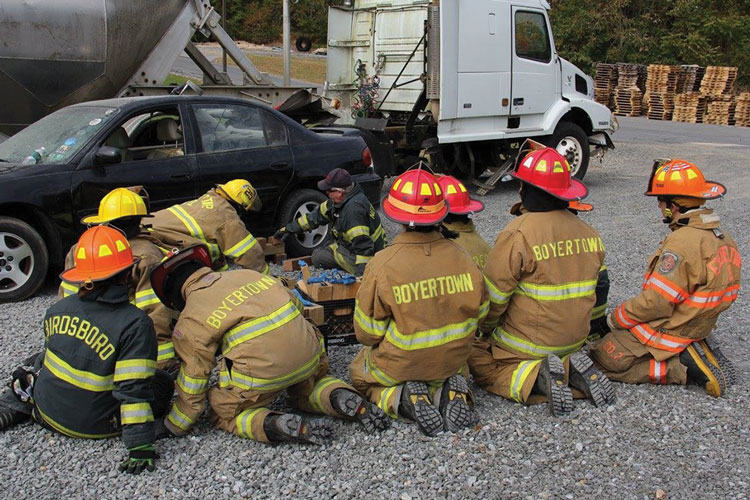
By DON KERNAN
For generations, the ranks of volunteer fire companies were filled with the children and grandchildren of firefighters who bravely walked through the bay doors to continue a proud family tradition. Spurred on by a sense of duty, a fire in their blood, hopes of a fire service career, or maybe even just a kick in the backside, that next generation was taking its first steps into our honorable profession, becoming part of the 69 percent of American firefighters who risk their lives without expectation of compensation.
Times have changed, and the kids aren’t walking through the doors as much anymore. There are many reasons for this: Whether it is because of social media, political attacks from all sides against what we do, or just what is called the “Now Generation,” volunteer fire companies around the country are entering a crisis stage in their ability to put properly staffed apparatus on the street rapidly. For the purposes of this discussion, “kids” loosely means any member or potential member of a fire company under the age of 18. This problem means many firehouses are facing the real possibility of closing their doors and not being able to protect their communities.
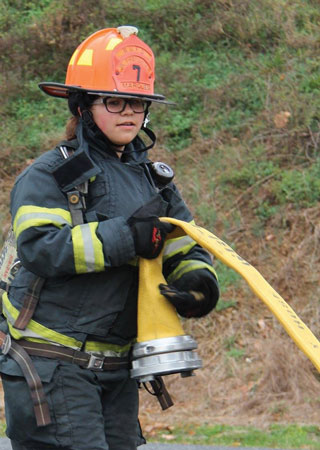 |
| (1) A junior firefighter from the New Egypt (NJ) Volunteer Fire Company pulls hose. (Photos by Paige Kahler, Five Points Photography.) |
So, what can we do? First, acknowledge that there is a problem, which is not as easy as it seems. Decades of doing things the same way as well as “old-school” thinking provide roadblocks to new ideas. Only when departments take an honest look at themselves are their members able to seriously address the issue. There needs to be an objective perspective of where the department stands to determine how to close the gap that is forming.
Sadly, many volunteer departments can no longer sit and wait for young men and women to come to them. Departments have to become proactive in their recruitment of young talent. Even more important, they need to have an organized junior firefighter program in place to capture and keep these new members’ interest. If departments don’t proactively compete with the ever-changing demands on young people, they will lose them to the next thing that comes their way.
Once you’ve recognized this problem and you know there is a solution, how do you make it all happen? There are some basic building blocks; here are my “ABCs” to start a successful, sustainable junior firefighter program.
A: Advocate
Without a doubt, finding the right person to start and run a new program is the most important factor in whether or not your program succeeds. This person absolutely must be a tireless advocate for the program, its goals, and the kids who will be a part of it. Ideally, he should be a senior member as well as an active firefighter. This is not to say that younger members, say, with five years of experience or so, don’t have a place in the program; they can play “big brothers and sisters,” roles often needed with today’s junior firefighters.
The program advocate should have training officer or fire instructor credentials (although those may come later), since being in a leadership and educational role demands some background and education in itself. However, I do not believe the advocate should be, whenever possible, a line officer. In his role as advocate, he will often have to go to bat for junior firefighters if their conduct or learning strays. This will happen sooner or later, and when it does, if the advocate is also an officer, he will be conflicted between the two positions and the responsibilities that each carries. He must believe wholeheartedly in this oldest of canons: The best leaders take none of the credit and all of the blame.
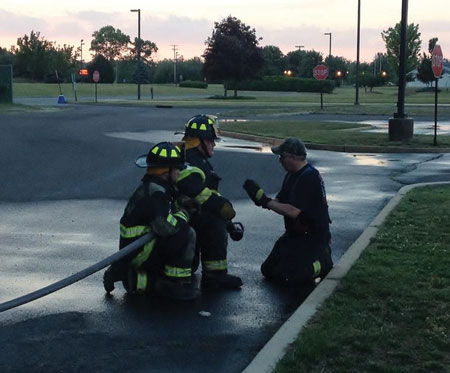 |
| (2) In photos 2-8, junior firefighters attend On Scene Training in Berks County, Pennsylvania. Finding the right advocate for the junior program is the most important choice a successful program must make. |
The advocate’s first battle will probably occur at his own company meetings. The initial suggestion of starting a junior firefighter program may be met with old-school thinking. Senior members who don’t want any “kids” around the firehouse might object to any thought of juniors, often citing worst-case scenarios as the reasons for their objections. The advocate will have to take responsibility for these perceived incidents long before any occur.
Consider the concerns some senior members will have about starting a junior program: underage drinking, theft of equipment, and reckless or inability to drive to the firehouse. With very few exceptions, these tend to be unfounded concerns. Further, you can deal with these concerns when you write the program’s standard operating guidelines (SOGs).
Finding the perfect advocate to run your junior program does little if you still don’t have the kids walking through the door. If candidates are not coming to you, go to them. High school career days, county fairs, and town festivals are all places where a volunteer department may set up a table and allow the advocate to meet kids face to face, talk to them about the fire service, and raise interest in the junior program. At this event, demonstrations with apparatus and equipment, especially by young firefighters who are not much older than the kids, are excellent ways to initially engage recruits.
 |
| (3) How junior firefighters train is something that varies from state to state. |
Another way to recruit is to reach out to the faculty at your local high school. Talk to a counselor or senior staff member about the program and your ideas. Be clear that boys and girls are welcome. Encourage schools to recognize that the kids are one of three parts-in addition to the fire department and the recruits’ families-to a successful program and, more importantly, successful junior firefighters. Getting someone at the school to understand and believe in your program, as I did when our program was just starting, will go a long way toward ensuring its success. With today’s testing-focused education, it will probably take more than one meeting at the school to convince the powers that be of your program’s worthiness, not just to the fire department but also to the school.
When the school participates, the students it recommends will often have some issues. That is why, in addition to an advocate, well-written company- and attorney-approved SOGs on junior firefighters and the program must be in place before the first juniors enter the firehouse.
Last, fire companies must build a presence on social media. This goes a long way toward recruiting and building good public relations. Your department should formally decide on what information you want your recruits and your constituents to see and what to withhold; training and basic call briefs are okay, but information and graphic content not protected by the Health Insurance Portability and Accountability Act are not. Show what the firefighting experience is all about and why someone who is interested should take the next step and join.
B: Boundaries
Your company must have SOGs in place before the first junior firefighters enter the firehouse. These SOGs will be similar to other department SOGs and must deal with the many subjects that concern the program and the junior firefighters. They must set boundaries for junior firefighters inside and outside the firehouse and clearly state the consequences when those boundaries are exceeded.
The most basic boundaries concern the age at which a recruit can join the junior program. Your state’s laws or your department’s insurance coverage may dictate the age the program sets. Some companies have Explorer programs that start at age 14. With other programs, the junior must wait until his 16th birthday to join.
With all due respect to companies that have Explorer programs, the best plan is to start junior firefighters who are 16 years old. Although there are a few reasons for this thinking, a primary one is that the recruits’ attention spans and maturity are still developing during those years. You will most likely be instructing the juniors in one group, trying to keep the 14-year-old’s attention in the process, while trying to instruct the 17-year-old; this will be distracting to both ages. In the end, you may lose both.
Inside the firehouse. What the juniors can do and when they can be in the firehouse are two important questions you must consider. These subjects will most likely represent the first “fight” the advocate has at a department meeting.
If your department has a bar or social hall that it rents out for fundraising, can the juniors work where alcohol may be present? Are they allowed access to the firehouse and other fire company buildings without a senior member present? Are they allowed to respond to all calls, regardless of the type or time? You need to address these questions in your SOGs and meetings before that first young recruit walks through the door.
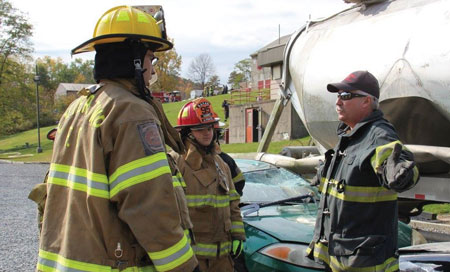 |
| (4) Abilities to learn, both mentally and physically, vary greatly in the 14- to 17-year-old age range of some programs. |
In our program, the juniors were allowed to work the rentals but not have contact with alcohol in any way. Our firehouse has an electronic entry system that uses key fobs; we do not give the juniors keys or key fobs until they turn 18 and become probationary firefighters. They are also not allowed to be in any department building alone.
Regarding when and to what type of calls they respond, we set a curfew of 10 p.m. on school nights and midnight during the weekends. We also prohibit them from answering calls before 6 a.m.
Finally, they are not allowed on any apparatus that is responding to a mutual-aid, rapid intervention team, or hazmat call. They are also not allowed on the apparatus unless they are instructed by the officer or a senior member. This is why having your officers and senior members on board with the program and its goals are so important. Bear in mind, however, that a junior firefighter who is always left at the station as the truck is pulling out will probably not be a junior for long. Get the juniors engaged in the department as well as department members engaged in the program early on; that is the best way to break down the walls of that old-school thinking.
Outside the firehouse. Our junior program is best represented as a “triangle,” with the junior firefighter in the middle. The three sides of the triangle represent the fire department, the junior’s home, and his school. Each is equally important in the development of the program and the juniors. It is also the reason a junior firefighter’s behavior and actions at home, at school, and on the street will almost always have a ripple effect on the fire department. This is the reason, again, it is important to have SOGs in place.
Do you set a minimum grade point average (GPA) for your junior program? What happens to an existing junior firefighter if he doesn’t maintain that GPA? What happens when a junior’s home life changes in a way that affects his being in the program? What happens when a junior firefighter gets in trouble in school or with the police? The many issues involved here will probably make an SOG that addresses every scenario impossible to maintain, but you can plan and prevent confusion later by addressing the most common and plausible events immediately as well as outlining a plan for later occurrences. Our SOGs set a 2.0 (C average) as a minimum qualifying GPA, and each quarter’s report card must be presented to the department as verification. Juniors who fall below this standard are not allowed to respond to calls, but they are allowed at drills. In addition, because we had the backing of the counselors at the high school, we would often contact them to see how we could help get our firefighter back on track. When trouble at school arose for a junior firefighter, as the company advocate, I was often contacted before the parents to deal with the issue.
 |
| (5) Training alongside the active firefighters provides an opportunity to learn and accept each other as fellow firefighters. |
Regarding any issues with police, if the incident is a minor run-in, our local police would often contact our chief, who would then pass the incident on to me to handle. With anything major, the juniors were told up front at their first meeting that they are not full members and, as such, could be kicked out of the department at any time for any reason the department saw fit, without appeal.
Dealing with a junior firefighter’s home life and how it affects him is often a more fluid situation. School counselors will sometimes recommend students who have personal issues to the program. More often than not, these issues involve their home life. Before a recruit is brought in as a junior, we meet with his parent or guardian to talk about the program and what is expected of a junior firefighter. The parent is also given a form to sign, giving permission for the child to be part of the program. The parent is then given the advocate’s phone number to use at any time if there is a concern or question once he is told that he’s expected to be an active participant in the junior’s development. As such, the parent can pull the junior from the program at any time. The advocate must now be ready to receive calls from the parent for help in dealing with the junior’s behavior. Again, it is important to have the right advocate who is the junior’s “best friend and worst enemy.” He cannot replace the parent or take on the parent’s responsibility, but he can use his position and advice to help get the junior back on the right track at home and at school.
On a few occasions, a junior’s home life temporarily disintegrated to the point where he could no longer live there. On those occasions, after discussions with the parents and the school, the junior moved in, temporarily, with me and my family. This allowed the lines of communication to reopen; the emotions to subside; and, after a brief time, the junior to return home.
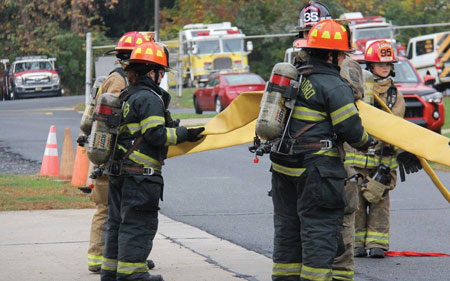 |
| (6) Repetitive hands-on training is the best way to train junior firefighters. |
This is not an option for everyone. However, on the occasion when this did happen in our department, it worked. It also allowed me to show the department what the brotherhood was all about; despite their newness to the fire service, these junior firefighters were also my brothers and sisters, and the brotherhood would always be there for help and support. This lesson often led new recruits to the program after they were told how some firefighters and the brotherhood helped and supported their friend when he needed it.
Regarding boundaries, to get the program up and running, it may be necessary to set the SOGs, at least initially, to be stricter than the program supporters would like. This may be necessary to gain the approval of those against its implementation or even those on the fence. As time progressed, I found that, as the program became fully implemented and accepted, we were able to ease off a bit on restrictions, and some of our juniors continued on to become officers. The SOGs, too, would grow and change, becoming less rigid and more accepting of the issues and problems that may arise as a junior firefighter progresses through the program with personal experiences.
C: Classroom
When; what; and, most importantly, how do you teach the junior firefighters in your program? Developing the program that gets juniors through the front door will mean little if they grow frustrated and lose interest once inside.
When. The easy answer as to when the advocate should teach the juniors is always. One thing I tell my juniors when they join is, “Learn one thing, just one thing, every time you walk` in the door.” It is the advocate’s job to help them with that task at the firehouse; on the training ground; and, whenever possible, on the fireground.
In addition to our regular training nights (which the juniors were expected to attend), we had a bi-monthly “Junior Firefighter Training Night” where we stressed basic skills. Juniors, who can sometimes be intimidated on regular drill night, are encouraged to ask questions, and we assure them that there are no dumb questions. This is where the advocate develops the sense of trust between himself and the juniors that will eventually help their training and program progress.
What. This aspect will vary from state to state, depending on what junior firefighters are allowed to be taught. For example, in my home state of New Jersey, child labor laws prevent junior firefighters from handling any hydraulic or engine-driven tools or from “participating in training that involves fire, smoke, toxic or noxious gas, or hazardous materials or substances.” In Pennsylvania, where I have also taught, juniors are allowed to participate in exterior firefighting, in training, and on the fireground.
After the local rules are considered, it is important to give the juniors instruction that will easily translate into their ability to assist on a fireground or rescue ground. Familiarization with tools in the compartments of the apparatus, the uses of these tools, instruction in the basic operations on the fireground, and hands-on instruction in handline and supply line deployment will have some positive effects on the junior firefighters and the program. First, it can affect the juniors’ ability to provide support duties on the fireground by freeing senior firefighters for more primary duties. Second, it will show the firefighters the juniors’ abilities. Finally, it will give the juniors that sense of belonging, of being part of something more than just a junior program.
We all remember our first call. Getting your juniors to that first call and giving them the ability to be more than just spectators will keep them coming back. After the next school day, you may even get a few calls from their friends inquiring about your program.
How. Teaching today’s recruits is often one of the toughest things about the program, and it will vary from year to year and even junior to junior. Seasoned instructors often have problems teaching junior firefighters. The advocate and anyone else who assists in the instruction must remember that these juniors are new to all aspects of the fire service. The juniors, despite their age, with very few exceptions, are basically in fire service “preschool.” They have to be instructed and treated with that thought in mind but not talked to as if they’re children. It’s a delicate balance.
The juniors’ progress, especially during the beginning of their training, will often be measured in “baby steps.” In addition, many of my juniors have had some learning issues, which can also affect the methods of instruction. I have found that a patient, slow-teaching method that relies heavily on repetitive, hands-on instruction is the most effective method, but you will need to assess that based on your program and recruits.
 |
| (7) Having junior firefighters train as close as possible to the boundaries set by the state or company is key in keeping their interest. |
The advocate must be able to read his juniors and change his teaching method as their unpredictable attention spans change. Keeping the juniors active and working and giving them a sense of purpose and belonging-at the firehouse and on the fireground-are the best ways to turn your junior firefighters into active firefighters and department members.
Today, modern volunteer fire departments face many issues that challenge their ability to fulfill their duties to the communities they serve. Having the personnel to carry out those duties is on top of the list of these issues. We can no longer simply expect the next generation of firefighters to walk through the door to refill our ranks. Volunteer fire departments must be proactive in their search for these potential firefighters. By following these ideas and creating a junior firefighter program of your own, you can set into motion your department’s ability to refill its ranks with young, enthusiastic volunteers year after year. One day, your program’s advocate will have the same honor and pleasure I have had: being led down a smoky hallway by a confident officer who, not many years ago, was one of my first kids.
DON KERNAN is a 16-year fire service veteran and an assistant chief and president with the New Egypt (NJ) Volunteer Fire Company (NEVFC). He has also served with the Falls Township (PA) Volunteer Fire Company. Kernan is a New Jersey (NJ) Level 1 fire instructor and a NJ certified fire officer and strike team leader. He started a junior firefighter program at NEVFC, where many of his students are now his officers. Kernan also works for On Scene Training Associates with probationary and junior firefighters in hands-on and classroom training.
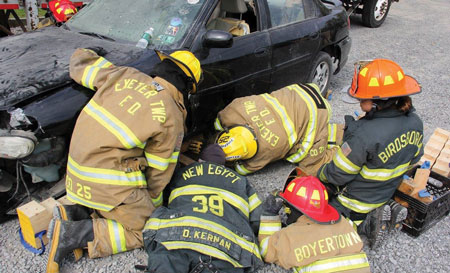 |
| (8) Having junior firefighters train as close as possible to the boundaries set by the state or company is key in keeping their interest. |
Battling the Brain Drain
Adjusting to our Evolving Fire Service
Junior Firefighters Challenge
Fire Engineering Archives

